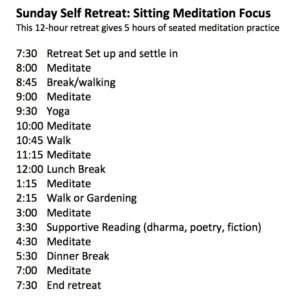 There is no better time for self retreat. This is a perfect time to relax in silence and do nothing. Take a break from worry, overwhelm, stress, over-connecting and trying to figure it all out. Relax your mind and give it the tender care and quiet it so dearly deserves and needs.
There is no better time for self retreat. This is a perfect time to relax in silence and do nothing. Take a break from worry, overwhelm, stress, over-connecting and trying to figure it all out. Relax your mind and give it the tender care and quiet it so dearly deserves and needs.
People like me who have spent a lot of time on retreat, whether at home or in retreat centers, are well aware of the valuable opportunity offered in this time of sheltering in place.
But most people I know do not go on retreats, so I thought I’d offer a few bits of advice on how to put one together in five easy steps, honed from my years of personal practice and my nine years working as a retreat manager at Spirit Rock Meditation Center.
What is a Retreat?
I’m broadly defining a “retreat” as a period of loosely 3-4 hours or more of intentionally withdrawing into privacy and contemplation. Self retreat is time out. It is solo. It is intentional. It is both rest and a chance to digest. It can involve formal meditation, or not.
We can retreat at home (yes, even if we live with others), or elsewhere. It can last for a few hours or for several days or more.
When we are quiet for a period of time like this we naturally come into balance in our bodies and minds.
In the suggestions below I assume you will do sitting meditation as part of your self retreat. However, if that doesn’t interest you, feel free to swap “meditation” with “silent time” or “prayer” or any activity you can do in silence that will allow you to withdraw from the world and just be with your own body/mind/heart.
Putting Together Your Retreat
To create your retreat you need the following:
- A Plan
- A Schedule
- A Space with Props
- Unplug and Get Started
The Plan
Creating your own self retreat mostly requires that you think through why you want to retreat and how you want to structure it.
You’ll want to consider the following elements:
- Your intention & focus
- Length of retreat
- What practices will you do?
- Will you incorporate any other activities?
Here are some possibilities to consider:
Intention & focus: You want to rest, be alone, unplug/disconnect from devices, focus on a problem or task, stop worrying, be in touch with your true self, spend time on spiritual practice, spend time writing or doing artwork, clean, connect with nature, get clear about an issue, do nothing.
Length of retreat: 4 hours, 6 hours, 8 hours, 2 days, 3 days, 1 week
Practices: sitting meditation, prayer, yoga, qigong, walking
Other Activities: drawing, writing, gardening, carpentry, cleaning
The Schedule
 The key to a good retreat is a good schedule. And when you self-retreat (as opposed to joining a formal retreat), you get to create the right schedule for you.
The key to a good retreat is a good schedule. And when you self-retreat (as opposed to joining a formal retreat), you get to create the right schedule for you.
Whether the retreat is 3 hours or 3 days you’ll want to create a detailed schedule of activities so you can stay on track and not just drift off into “normal” daily life.
The schedule is probably the most important tool in your retreat toolbox. If you don’t have a retreat schedule, you may have no idea what to do next after that 1 hour 6AM sit. The schedule creates movement and momentum. It also gives you breaks.
Some tips for creating your schedule:
- Be realistic about the length of your sits, breaks, and how long the day will last.
- If you plan to sit a lot, be sure to break it up with some kind of movement – even if it’s just walking around the block for 15 minutes.
- You can mix up how long the sitting periods are.
- Allow for rest time. That is also part of your retreat.
The Props and Setup
The day of your retreat you’ll want to set aside the props you need for your retreat. For some this will require nothing more than a chair, a blanket, and a time piece. For others, it may be more complicated – especially if you want to include reading materials, audio recordings, etc.
Retreat Props: meditation cushion, chair, yoga mat, time piece, incense, blanket, outdoor gear, books, poetry, recordings, candles, journal
Pre-Retreat Setup: vacation message, talk with family members/roommates, prepare and print the retreat schedule, clean/neaten space for practice, food prepared for meals, everything unplugged and offline
Unplug and Get Started
Unplug! Literally turn off devices. Hide them in drawers. Put covers over them. If you must use a phone or ipad as a “timer” make sure it’s set to airplane mode.
The privacy and silence of your retreat experience far outweighs any justifications you may come up with for staying connected.
One reason many of us choose to retreat is to give ourselves a break from our addictive behavior patterns with our phones and computers. Some of us have never been offline for even a day since first purchasing whatever devices we’ve come to rely on.
Self-retreat is an opportunity to be with just you. No one else. It’s a date with yourself. Respect that choice.
And not to worry, when you meditate you’re bound to have plenty of conversations in your head. You really won’t feel lonely. Thoughts will chatter away keeping you company as you make an effort to focus on the breath or whatever your contemplation object is.
But the gift of self retreat is that you give your psyche, body, and mind, space to just be. This is your cave, your top of the mountain, your island. Enjoy it.